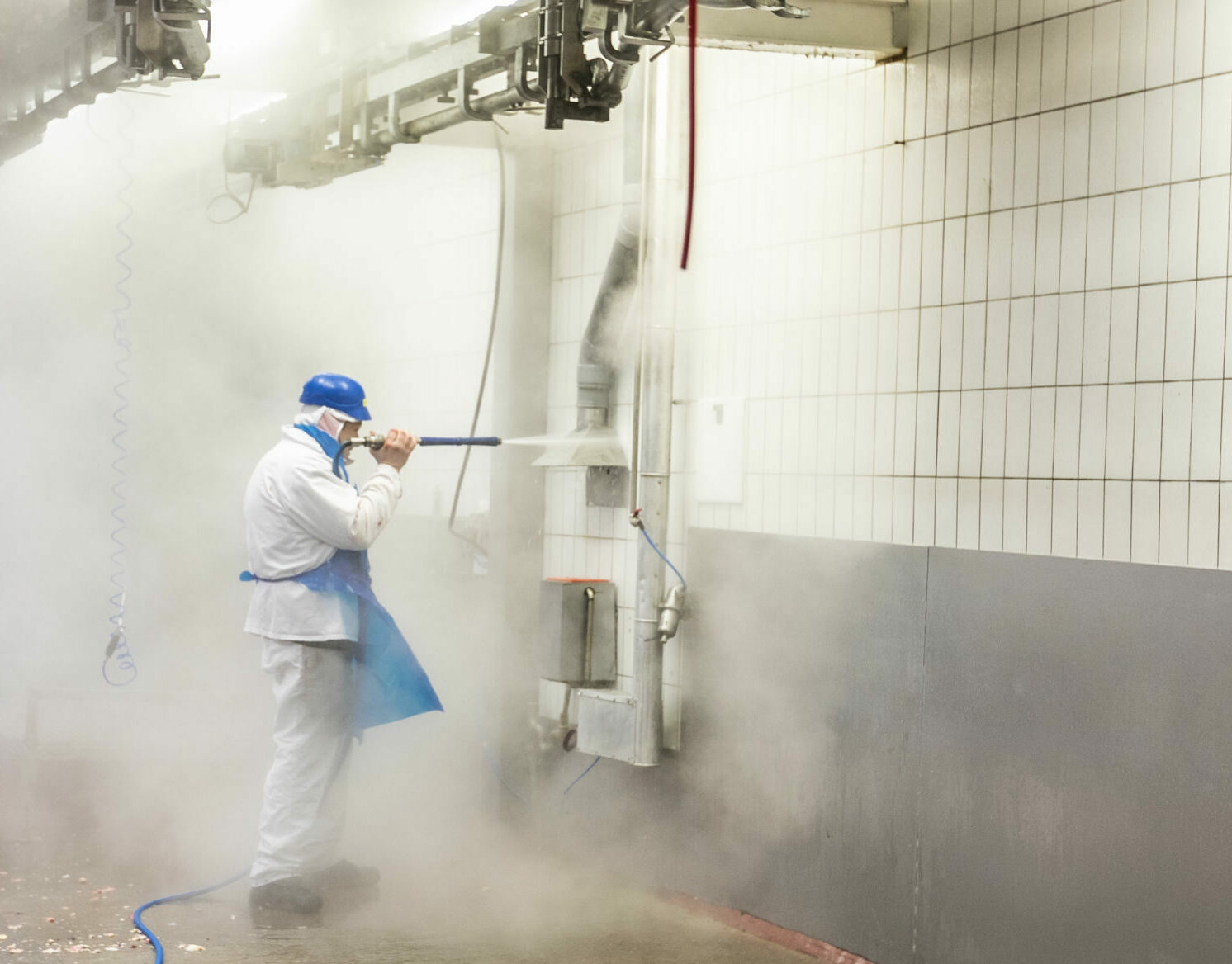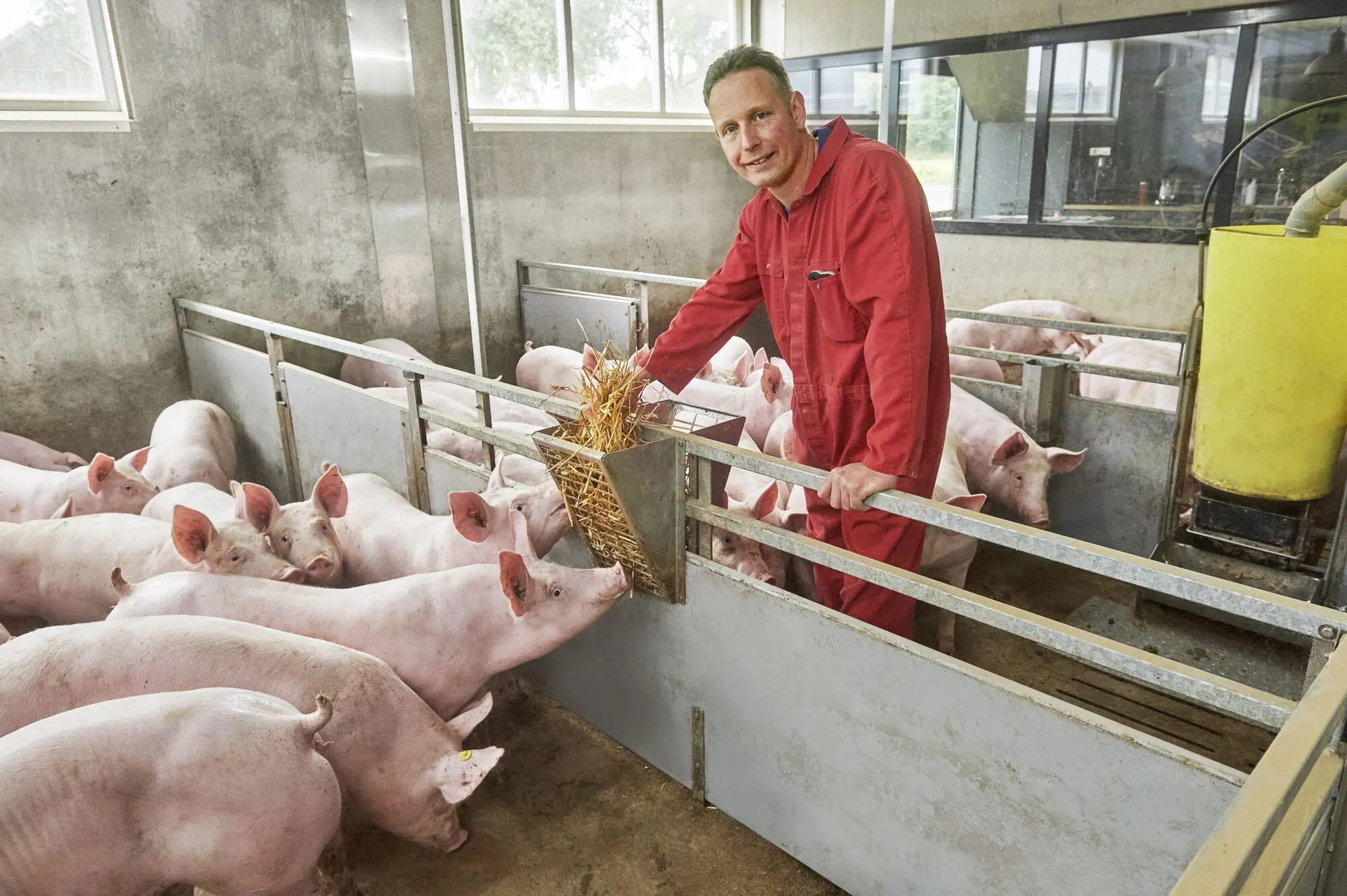
Inspection results pigs
Live inspection upon arrival at abattoir
When the animals arrive at the abattoir, they are individually inspected by trained veterinarians from public authorities. The veterinarians pay particular attention to the health and welfare of the animals. Only healthy animals may be slaughtered and the welfare of all animals is safeguarded. If there is reason to doubt the health and/or welfare of an animal, the veterinarian carries out an additional examination.
The inspection of live animals is an important element in ensuring the safety of the meat for consumers. Besides a focus on the safety of the food, the suitability for the slaughtering process is also carefully examined by the government veterinarian. If necessary, slaughtering will take place with extra attention and at a lower speed.
Live inspection
pigs per quarter
1.637.184 pigs per quarter
Immediately approved at the live inspection
Got remarks during the live inspection
1.588.040 pigs per quarter
Immediately approved at the live inspection
Got remarks during the live inspection
1.616.035 pigs per quarter
Immediately approved at the live inspection
Got remarks during the live inspection
1.761.989 pigs per quarter
Immediately approved at the live inspection
Got remarks during the live inspection
1.740.011 pigs per quarter
Immediately approved at the live inspection
Got remarks during the live inspection
1.826.038 pigs per quarter
Immediately approved at the live inspection
Got remarks during the live inspection
1.873.024 pigs per quarter
Immediately approved at the live inspection
Got remarks during the live inspection
This filter options do not have any results. Please adjust the filters to get some results
The “live inspection” chart shows the results of the official veterinarian’s decision regarding the inspection of individual animals:
Approved: Proportion of pigs authorised for slaughter for food production
Not approved: Proportion of pigs not authorised for slaughter for food production
Meat inspection - Food safety
After inspecting live animals, the meat of each carcass is inspected during the slaughtering process. Inspectors and veterinarians from public authorities carry out this inspection. All parts of the animals are carefully inspected. Only meat that is absolutely safe is approved. Here, too, any reason for doubt means that extra examinations are carried out by public authorities.
The inspection results of the meat inspection (food safety) are summarized in the graph below. In the archive you will find the NL inspection results of the previous quarters and years.
Meat inspection - Food safety
pigs per quarter
1.631.204 pigs per quarter
Approved
Not approved (not suitable for consumption)
1.582.190 pigs per quarter
Approved
Not approved (not suitable for consumption)
1.761.989 pigs per quarter
Approved
Not approved (not suitable for consumption)
1.740.011 pigs per quarter
Approved
Not approved (not suitable for consumption)
Approved
Not approved (not suitable for consumption)
Approved
Not approved (not suitable for consumption)
Approved
Not approved (not suitable for consumption)
Approved
Not approved (not suitable for consumption)
Approved
Not approved (not suitable for consumption)
Approved
Not approved (not suitable for consumption)
Approved
Not approved (not suitable for consumption)
Approved
Not approved (not suitable for consumption)
Approved
Not approved (not suitable for consumption)
Approved
Not approved (not suitable for consumption)
Approved
Not approved (not suitable for consumption)
Approved
Not approved (not suitable for consumption)
Approved
Not approved (not suitable for consumption)
Approved
Not approved (not suitable for consumption)
Approved
Not approved (not suitable for consumption)
Approved
Not approved (not suitable for consumption)
Approved
Not approved (not suitable for consumption)
Approved
Not approved (not suitable for consumption)
Approved
Not approved (not suitable for consumption)
Approved
Not approved (not suitable for consumption)
Approved
Not approved (not suitable for consumption)
Approved
Not approved (not suitable for consumption)
Approved
Not approved (not suitable for consumption)
Approved
Not approved (not suitable for consumption)
Approved
Not approved (not suitable for consumption)
Approved
Not approved (not suitable for consumption)
Approved
Not approved (not suitable for consumption)
Approved
Not approved (not suitable for consumption)
Approved
Not approved (not suitable for consumption)
Approved
Not approved (not suitable for consumption)
Approved
Not approved (not suitable for consumption)
Approved
Not approved (not suitable for consumption)
Approved
Not approved (not suitable for consumption)
Approved
Not approved (not suitable for consumption)
Approved
Not approved (not suitable for consumption)
Approved
Not approved (not suitable for consumption)
Approved
Not approved
This filter options do not have any results. Please adjust the filters to get some results
Approved: the pig’s carcass has been assessed as being suitable for human consumption.
Rejected: the pig’s carcass has been assessed as unsuitable for human consumption.
Meat inspection - organ findings
During the official meat inspection, in addition to the examination of the carcass, all organs of an animal are examined by official veterinarians and specialist assistants. Only organs that are safe for human consumption are allowed for further processing. The carcass and organs provide information about the animal health status of an entire herd. Findings are saved for each individual animal and reported back to the farm. With this information the farmer can make decisions about the animal health management of his livestock.
The inspection results of the meat inspection (food safety) are summarized in the graph below. In the archive you will find the NL inspection results of the previous quarters and years.
Meat inspection - healthy animals
pigs
1.637.184 pigs per quarter
Without findings
With findings
1.588.040 pigs per quarter
Without findings
With findings
Without findings
With findings
1.740.011 pigs per quarter
Without findings
With findings
Without findings
With findings
Without findings
With findings
Without findings
With findings
Without findings
With findings
Without remarks
With remarks
Without remarks
With remarks
Without findings
With findings
Without remarks
With remarks
Without findings
With findings
Without remarks
With remarks
Without findings
With findings
Without remarks
With remarks
Without findings
With findings
Without remarks
With remarks
Without findings
With findings
Without remarks
With remarks
Without findings
With findings
Without remarks
Without remarks
Without findings
With findings
Without remarks
With remarks
Without findings
With findings
Without remarks
With remarks
Without findings
With findings
Without remarks
With remarks
Without findings
With findings
Without remarks
With remarks
Without findings
With findings
Without findings
With findings
Without findings
With findings
Without findings
With findings
Without findings
With findings
Without findings
With findings
Without findings
With findings
Without findings
With findings
Without findings
With findings
Without findings
With findings
This filter options do not have any results. Please adjust the filters to get some results
Left graphic:
No findings: no findings were found during the investigation
With findings: one or more findings were found
Right graphic:
Proportions of pigs with findings of which:
Liver: findings on the liver indicate the presence of parasites during rearing
Lungs, pleura, pericardium: findings in these organs show that the pig went through a respiratory diseases during rearing.
Skin: these findings indicate skin infections during rearing
Joint: findings here provide evidence of inflammation of the joints during rearing
Abscess: an abscess is an encapsulated collection of pus that can develop following localised bacterial inflammation
Bowel: a finding indicates an inflammation of the bowel. This can be caused by a nutritional disorder, parasitic or an infection
Auxiliary bursa: can be damaged by increased mechanical stress on exposed areas, e.g. B arise at joints
Antibiotics
The use of pharmaceuticals in animal husbandry is strictly regulated and may only take place after a thorough diagnosis and prescription by a veterinarian. After medication has been administered, statutory waiting times must be observed before a pig can be slaughtered for food production. The use of the medicinal product must be documented in detail by the farmer. Compliance with the rules is checked with official residue examinations at the slaughterhouse.
An official control program specifically focuses on checking the presence of antibiotic residues in meat. 0.5% of all slaughtered pigs undergo an official examination for antibiotic residues.
Official residue tests - antibiotics
3.281 pigs examined
Without findings
With findings
34.271 pigs examined
Without findings
With findings
35.007 pigs examined
Without findings
With findings
12.294 pigs examined
Without findings
36.640 pigs examined
Without findings
With findings
This filter options do not have any results. Please adjust the filters to get some results
No findings: no evidence of antibiotic residues
With findings: the legal limit values for antibiotic residues were exceeded
National residue control plan
As part of the annual national residue control plan, the official veterinarian carries out further examinations at the slaughterhouse. Meat and organs are examined for drug residues as well as undesirable and prohibited substances using targeted random samples. The individual substances to be examined can be found here.
The frequency and the substances to be examined are specified within the framework of a nationwide program that is coordinated by the Federal Office for Consumer Protection and Food Safety (national residue control plan). Every 2000th pig slaughtered is examined within the framework of this national residue control plan. More information on the national residue control plan.
Official residue inspection - national residue control plan
1
3.281 pigs examined
Without findings
With findings
3.637 pigs examined
Without findings
With findings
3.600 examined pigs
Without findings
1.290 pigs examined
Without findings
With findings
3.990 pigs examined
Without findings
This filter options do not have any results. Please adjust the filters to get some results
Without findings: no evidence of drugs and undesirable substances
With findings: exceeding the legal limit value for drugs and/or undesirable and/or prohibited substances









